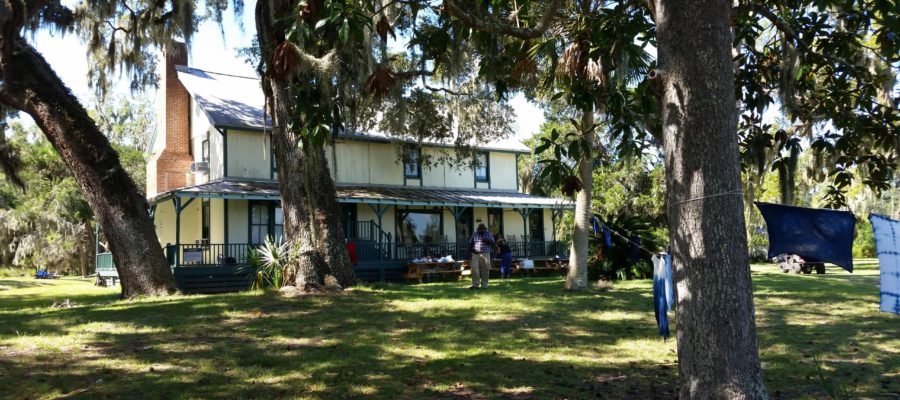Have you ever heard of Ossabaw Island? Probably not. I didn’t until my husband and I took a walking tour in Savannah called The Indigo Journey Walking Tour, led by Ms. Karen Wortham. Ossabaw Island is primarily used for education, research, and cultural study.
The oldest resident from the island, Sandy West just turned 107 years old. Her family once owned the entire island. Eventually the family sold it to the State of Georgia for $8 million. There was an agreement for selling the land under one primary condition and it was to preserve the island in it’s natural state.

Journey to Ossabaw
The journey to Ossabaw Island began like this. Back in September 2019, my husband and I took a trip to Savannah, GA one Sunday morning. We caught a small boat along with four other passengers who just happened to be from Charleston like us to the secluded and undeveloped island. The premise of the trip was to participate in an indigo dyeing class. Ms. Karen Wortham, historian and tour director highly recommended it when we last visited Savannah, so we were stoked to do it. The thing is, the class is only held one weekend per year in September.
Scenery on Ossabaw Island
Ossabaw Island is comprised of 26,000 acres along the the deep blue waters of the Atlantic Ocean. It’s not filled with homes, condos, grocery stores, or eateries. The island is very isolated, but surrounded by water, marshes, and plenty of tall trees.
Once our boat arrived to the dock, Robin Gunn, project coordinator of The Ossabaw Island Foundation greeted all of us with a warm friendly welcome. If you were able to walk, you walked to the main house where the dying would take place. My toe was broken and causing some pain, so I decided to ride on the golf cart.
Club House
The big wooden house has a wrap-around porch, gift shop, and restrooms. You have to take off your shoes to walk inside. I declined to do that. I’m a germophobe. And on top of that, I also waited to use the restroom until we got back to the dock on the mainland. Had I known about the no-shoes inside thing in advance, I would’ve planned accordingly. It was okay because it’s not like we were out there for 12 hours.
The clubhouse is one of the main places guests can stay overnight. I think it would be so cool to stay overnight. As long as I have food and a few books, I think I’d be okay. If you do plan to stay you’d need to bring your food because again, there are no stores on the island.

Tabbies
There are 3 former homes of the enslaved called tabbies. When you walk down a little further to the left of the clubhouse you can’t miss it. The tabbies have been preserved. One tabby has a tin roof, while the others have a wooden roof. The exterior is composed of seashells. I’ve never seen any like that before.

We were able to go inside one of them. I tried imagining a whole family living there today. However, there was a family still living there in the 1970s. During the discussion of indigo history, I was indeed pleased that Ms. Donna Hardy, indigo expert, acknowledged that the enslaved people were the ones primarily cultivating the indigo although many folks give credit to Eliza Lucas Pinckney.










Indigo Facts
- It’s a green plant
- Produces blue color once extracted and oxidized
- Brought to SC from the Caribbean by way of Eliza Lucas Pinckney
- Several species of indigo are from Africa, India, and Latin America
- Was a very profitable commodity
- Initially grown along the coast of South Carolina

Indigo 
Indigo Dying
This was a neat experience. We all grabbed our complimentary shirts along with other personal items. There were ladies who really came prepared with linens, cloth napkins, bed sheets, etc. I was like OMG! Anyway, you’d think that the complimentary shirts available would be: Medium, Large or XL. Nope. The majority were Small. Looks like they ran low from the shirts supplied at the Saturday workshop. I was one of the smallest people present, but I grabbed the Medium. It really looked like a XS. Figured I’d give it to my nephew.
While learning about indigo, we had some visitors come join us. When I say visitors I’m referring to donkeys and love bugs. Those love bugs were the worst! The donkeys were super calm, but they did do some photobombing.


Dying Our Shirts
We were able to make our shirts decorative with shapes of stars, moons, and hearts by using small wooden pieces. Mine was rather plain and I was okay with that. My design method was by balling up my shirt and using mesh.
After wrapping and intertwining the shirts, we placed them in a bucket filled with water. This was in the event your shirt contained fabric softener, the dye wouldn’t adhere to the fabric. Next, we donned our elbow length rubber gloves that were provided. Then we walked over to the dye vats (large buckets) and submerged the shirts items into the vats for a few minutes. Afterwards we hung our shirts on the clothesline for it to dry. Do you remember having a clothesline? You don’t see those anymore. It probably took 45 minutes to 1 hour for the items to dry.
While waiting for the shirts to dry we had quite a bit of time to spare. Hubby and I wanted to stretch our legs so we went for a little walk, took pictures, and came back. The donkeys were walking around too. You can see them below at the smokehouse.
When we returned, the ever so pleasant, Robin began sharing with us her background and more about activities on the island like Descendants Heritage Day. That’s when people who lived and worked on the island return for a day of fellowship. The people include descendants of the enslaved, freedman (no longer enslaved), and owners of the land.



The Indigo Dying Process
To start the process Ms. Donna requested some help to pull the indigo leaves from the stems. I joined in near the end to get my hands-on experience. Sorry, I don’t have a picture of me in action.



Then we proceeded by watching the indigo oxidation process with Heather Powers another indigo expert and Ms. Donna. It was fascinating to see the leaves turn from green to blue.







End Results
We had a great time. Both of us learned a lot and met some cool and talented people. Oh and we were proud of the shirts we designed too. We even sent the pictures below to Ms. Karen too.

































